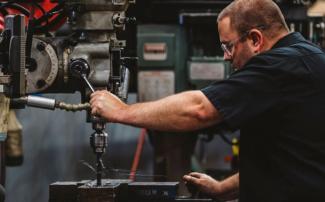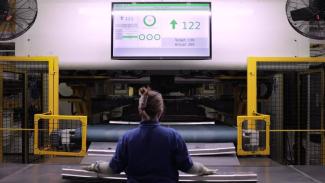Guide to Production Part Approval Process (PPAP)
Establish confidence in suppliers and their production process with PPAP. This article covers everything you need to know about how and when to perform PPAP.
PPAP (Production Part Approval Process) is a common term used in manufacturing that supports key activities and eases collaboration between suppliers and customers. It’s a standard method used across a range of industries, so it’s important to understand what PPAP is and why the process is necessary. In this guide, we will look at:
- What is PPAP?
- Why is PPAP Important?
- The Five Levels of PPAP
- How to Perform PPAP
- Who is Responsible for PPAP?
- APQP and PPAP
What is PPAP?
PPAP refers to the approval process for new or revised parts. It began as an important procedure in aerospace and automotive but is now used more widely throughout manufacturing. PPAP involves 18 steps that ensure the parts manufactured by suppliers exceed customers’ expectations and can be produced on a consistent basis.
There are five generally accepted PPAP submission levels. The full PPAP guidelines contain detailed information, instructions, and sample documents for completing the process requirements,
PPAP is part of APQP (Advanced Product Quality Planning), specifically stage four, which involves product and process validation.
Why is PPAP Important?
PPAP is important because it ensures essential parts are made to the correct engineering specifications and that the process is capable of consistently producing parts that meet those requirements. It also supports communication, letting suppliers know exactly what’s expected of them. These guidelines minimize the risk of things going wrong and corrective action needing to be implemented, benefitting both suppliers and manufacturers and creating a seamless partnership.
PPAP and other methods of quality assurance are being implemented across different manufacturing industries, which makes gaining an understanding of these processes important for remaining competitive against competitors.
Who is Responsible for PPAP?
Suppliers are responsible for the PPAP process. Responsibilities include maintaining a system that documents all the necessary elements required for PPAP submission.
PPAP 5 Levels of Submission
As we mentioned before, PPAP is a complex process but not all the different elements need to be completed to verify that production specifications will be met. The requirements of PPAP are usually negotiated during the quoting process. The PPAP report has five levels of submission, with Level 3 as the default level of PPAP submission approval.
- Level 1: Part Submission Warrant (PSW) only submitted to the customer.
- Level 2: PSW with product samples and limited supporting data.
- Level 3: PSW with product samples and complete supporting data.
- Level 4: PSW and other requirements as defined by the customer.
- Level 5: PSW with product samples and complete supporting data available for review at the supplier’s manufacturing location.
The Full PPAP Process
The full PPAP process involves 18 elements. The required steps depend on customer requirements and the complexity of the part being manufactured.
1. Design Documentation
This includes copies of the technical drawings from both the supplier and customer to ensure that everything aligns and meets the requirements. The documentation should also include a copy of the purchase order to confirm the correct part is being delivered.
2. Engineering Change Notice
A detailed description of changes made to an existing part if amendments were requested. This documentation is an Engineering Change Notice (ECN) and must be approved by the customer engineering department.
3. Customer Engineering Approval
The supplier needs to provide evidence that the customer engineering department approved the sample production parts.
4. Design Failure Mode and Effects Analysis (DFMEA)
A comprehensive risk assessment that considers all possible failures within the design needs to be carried out. These failures include product malfunctions, reduced performance or product life, and safety and regulatory issues. DMEA is a document that should be reviewed and updated throughout the manufacturing process.
5. Process Flow Diagram
This outlines the entire process for creating the part, including components, measurement, and inspection.
6. Process Failure Mode and Effects Analysis (PFMEA)
This reviews all of the steps involved in the manufacturing process to identify possible failures and document applied controls. PFMEA is also a document that should be reviewed and updated throughout production.
7. Control Plan
This plan includes the characteristics and inspection methods that will be implemented to ensure a stable and reliable production process.
8. Measurement System Analysis (MSA)
MSA includes Gage Repeatability & Reproducibility (GR&R) studies on measurement equipment used during production or quality control checks. Calibration records for gages and measurement equipment should also be included. This process ensures conformance to customer’s ISO or TS standard.
9. Dimensional Results
A validation check should be carried out to ensure the measurements on the drawing are correct and reflected in the end result. The results are recorded in a spreadsheet and included within the PPAP submission.
10. Design Verification Plan and Report (DVP&R)
This is a summary of every material and performance test performed on the part in production. It should include details outlining every test, when it was performed, how it was performed and the result.
11. Initial Process Studies
These studies include Statistical Process Control (SPC) and demonstrate that the critical processes are reliable and running near the intended nominal value.
12. Qualified Laboratory Documentation
This includes all the certifications from any lab testing that took place throughout the process. It includes in-house testing and offside contracted testing.
13. Appearance Approval Report (AAR)
A report that verifies the customer has inspected the final product and agrees that it meets all the required appearance specifications for the design.
14. Sample Production Parts
A sample part is given to the customer for approval. A picture of the production part and the location the parts are being stored are also usually included.
15. Master Sample
The final sample of the part is inspected and approved by the customer. This sample is then used as a benchmark for production in the future.
16. Checking Aids
This is a list of all the required checks to be done throughout production and details the inspection tools and calibrations used. Checking aids can include check fixtures, contour, variable and attribute gages, models, or templates.
17. Customer Specific Requirements
This is a list of specific requirements made by the customer for the PPAP process.
18. Part Submission Warrant
The Part Submission Warrant (PSW) is a summary of the entire PPAP submission process and includes the reason for submission, documents submitted to the customer, declaration signatures and a section for additional comments. The PPAP process is lengthy and detailed, but it ensures everything is planned and considered before and during production. The purpose of the process is to minimize errors, deliver a high-quality product, and ensure both parties are happy with the result.
APQP and PPAP
Production Part Approval Process (PPAP) is one component of Advanced Production Quality Planning (APQP), specifically the 4th phase of a 5-phase process. APQP refers to the process used for introducing a new product in the market or implementing changes to a product after its release. If the PPAP results don’t meet customer expectations, this means the APQP process isn’t working correctly and should be reviewed. We have an in-depth guide that covers everything you need to know about APQP and the role PPAP has in the overall process available on our website.



